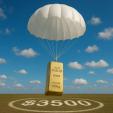US Dollar edges higher as June CPI reinforces Fed’s cautious stance
LONDON (July 15) The US Dollar (USD) rises sharply on Tuesday following the release of the June Consumer Price Index (CPI) report. While gains remain modest, the Greenback is finding some support as the data showed headline inflation in line with expectations, but core inflation came in slightly softer than forecast. The figures reinforced the view that while price pressure remains persistent, the Federal Reserve (Fed) may still take a cautious approach on rate cuts, keeping the prospect of policy easing on hold for now.
The US Dollar Index (DXY) is gaining momentum, trading near 98.30 during the American trading session. While the index remains supported, it faces a confluence of key technical resistance at current levels. The broader market tone stays cautious amid ongoing tariff threats from US President Donald Trump.
The US CPI report revealed a sharper pickup in price pressures for June. Headline inflation rose by 0.3% on a monthly basis — the largest increase in five months — bringing the annual rate up to 2.7% from 2.4% in May. Both readings were in line with market expectations. However, Core CPI, which excludes volatile food and energy components, increased by 0.2% MoM, below the forecast of 0.3% and up slightly from the 0.1% gain in May. On an annual basis, core inflation ticked higher to 2.9% from 2.8%, signaling persistent underlying price pressures despite the softer monthly print.
The report showed firm price gains across energy, transportation, and tariff-affected sectors, suggesting trade-related inflation is beginning to flow through to consumers.
Fed Chair Jerome Powell has clearly stated that uncertainty over the impact of tariffs is one of the main reasons why the central bank has held off on cutting interest rates. Powell highlighted that the Fed “went on hold when we saw the size of the tariffs,” and now intends to assess how deeply tariffs will filter through to consumer prices and growth before easing monetary policy.
While some Fed officials believe the tariffs may cause only a temporary rise in prices, many are worried that the inflation effects could be more lasting, making it harder for the Fed to lower rates in the near term.
Market Movers: Trump doubles down on tariffs and criticism of Fed Powell
- On Monday, US President Donald Trump announced plans to impose “very severe tariffs” — potentially up to 100% — on Russian exports if a peace deal with Ukraine is not reached within 50 days. In a further escalation, Trump also warned of “secondary tariffs” on countries that continue to engage in trade with Russia, particularly targeting those still importing Russian Oil and Gas. The move is aimed at isolating Moscow economically and increasing pressure on its trading partners, including China, India, and Turkey. These aggressive trade threats have heightened global market uncertainty and raised fears of further disruptions to global supply chains, particularly in the energy and commodities sectors.
- The yield on the benchmark US 10‑year Treasury note held steady above 4.43% on Tuesday, marking a one-month high as investors await today’s June CPI report. The sustained rise in yields reflects ongoing expectations that inflation may remain elevated due to tariff-related pressures, signaling that the Federal Reserve could delay interest rate cuts until price growth shows clearer signs of cooling.
- The second-quarter earnings season in the US begins this week, with major banks such as JPMorgan, Citigroup, and Goldman Sachs scheduled to report their results. Investors are closely monitoring the impact of rising costs and trade tensions on companies. Analysts expect modest earnings growth of about 5.8% YoY, well below the 10.2% estimate seen in early April, underscoring the impact of tariff-related uncertainties on corporate profits.
- US President Donald Trump has once again targeted the Fed Chair Jerome Powell. In comments made Monday, Trump called Powell a “knucklehead” and criticized him for keeping interest rates too high, arguing that rates should already be closer to 1%. He also claimed that Powell is hurting the economy by refusing to move faster on rate cuts. In addition to his policy criticism, Trump’s remarks come as his administration probes the Fed’s recent $2.5 billion headquarters renovation project, suggesting the costs were excessive and hinting at the possibility of firing Powell “for cause.”
- The Supreme Court has signaled that a president cannot remove a Fed Chair simply for policy disagreements, misconduct, or mismanagement could be grounds for removal. However, White House National Economic Council Director Kevin Hassett has stated that this issue is "being looked into" to determine if it provides sufficient cause.
- According to The Washington Post, Hassett is emerging as a leading contender to succeed Powell as the next Federal Reserve chair. Hassett supports President Donald Trump’s push for lower rates and risks being seen by the markets as lacking policy autonomy.
- Looking ahead, traders will be paying close attention to speeches from several Fed officials later today, following the stronger-than-expected US inflation data. Fed Governors Michael Barr and Michelle Bowman, along with Richmond Fed President Tom Barkin, are all scheduled to speak. With the next FOMC meeting approaching, any shift in tone could influence interest rate expectations and impact the US Dollar’s near-term direction.
FXStreet










